Uh Oh, Uco
March 31st, 2007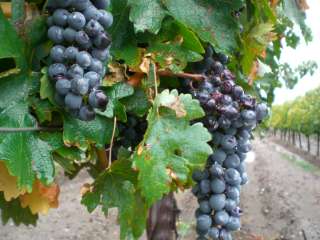
We found a small premium wine tour with Ampora Tours to the Uco Valley, the supposed “next Napa Valley” and home to the highest vineyards in the world at 1,100 to 1,300 meters. The sandy soil, sunny days, cool nights, lack of rain, and abundant spring water all create perfect conditions for great grapes with concentrated sugars and thick skins. After picking up the three other tourists we visited three vineyards of different sizes with our guide.
The tour was nearly continuous hilarity from the beginning and wine only added to the Canadian humour. Upon finding out the other tourists in the group were staying at the Park Hyatt, we started hypothesizing who would stay at this elite bastean of elegant class. I guessed Americans and Janet guessed Germans. Both wrong: two youngish Canadian women, Sharon and Linda from Vancouver, travelling on their oil and gas money. They vowed revenge if we published this picture of them. So be it.
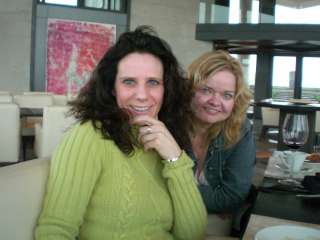
The first vineyard, Estancia Ancon, was the smallest vineyard with a production of 90,000 bottles. The Grande Reserve de la Familia blend of cabernet sauvignon, malbec and pinot noir, a limited edition of 6,000 bottles, was our favorite wine of the day, although our palettes were still fresh at the time. The atypical blend had a pleasant smoothness from the pinot noir and oak. The property’s villa can also accommodate tourists for an undisclosed sum.
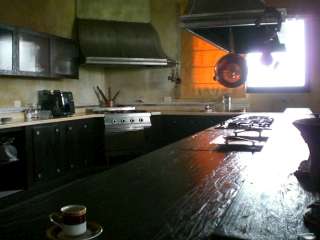 Andeluna, the second vineyard, was a little bigger. The suburban-country tasting room was warm, though a little contrived. We tried five wines with the 2005 Malbec and the 2003 Pasionado Blends being our favorites.
Andeluna, the second vineyard, was a little bigger. The suburban-country tasting room was warm, though a little contrived. We tried five wines with the 2005 Malbec and the 2003 Pasionado Blends being our favorites.
The last vineyard was O. Fournier. The owners told the architects that visitors should either hate it or love it, but never forget it. The ominous concrete structure fulfilled that mandate; it kind of looks like an airport terminal. To avoid pumping the wine, the lowest level is 20 meters underground. Whole grapes are crushed at the top level, then slide down to the fermentation vats on the next level, and then are aged in oak barrels on the last level. We toured the cellar on catwalks where we also viewed enourmous pieces of art from a local artist.
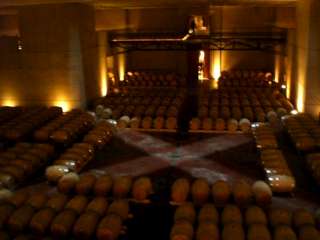
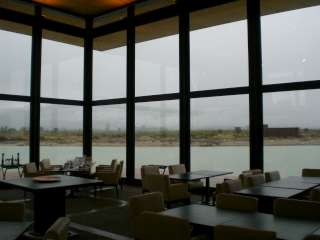
A highlight of the tour was the four course lunch at the winery’s by-appointment-only-restaurant. A colourful trio of warm soups—potato, pumpkin with pepper and greensquash with spring onion—were served in shot glasses and followed up with a few simple treads of julienned peppers and eggplant with oil and salt. We were surprised to find the Malbec held up to the red wine vinegar in the salmarejo, a cold gazpacho-like soup, which followed. Alfa Crux, a wine we tasted at Vines of Mendoza, accompanied the requisite beef entree. The dining room’s six meter high windows were intended to provide grand views of the Andes, but instead the clouds provided a white backdrop which only partially cleared.
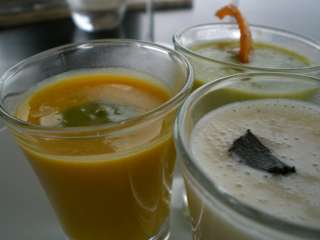
After a day of wine we were noisely cracking jokes and laughing and the two Canadian women setting the pace. As the only male in a party of six, I couldn’t offset the natural tendency of the drunk women to get rowdy and talk about men. Somehow, one of the owners’ father at the next table managed to fall asleep over the ruckus at the next table. Fortunately, the ladies directed most of their interest to the driver, the waiter and the security guard, who one hoped would require sexual favors in place of a lost receipt.
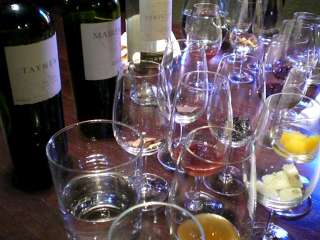 The special tasting room (!!) was prepared with three different, non-blended local wines: a Torrontes, a Bonarda and a Malbec. However, in addition to the wines, there were tasting glasses filled with the flavours that one is meant to experience in each wine. For example, the glass of Bonarda was accompanied by a glass each of earth, dried leaves, quince jam, and pepper. So, after one swirls and takes notes on the wines appearance, one is meant to sniff the aroma and compare it to the raw elements. How much fun is THAT!
The special tasting room (!!) was prepared with three different, non-blended local wines: a Torrontes, a Bonarda and a Malbec. However, in addition to the wines, there were tasting glasses filled with the flavours that one is meant to experience in each wine. For example, the glass of Bonarda was accompanied by a glass each of earth, dried leaves, quince jam, and pepper. So, after one swirls and takes notes on the wines appearance, one is meant to sniff the aroma and compare it to the raw elements. How much fun is THAT!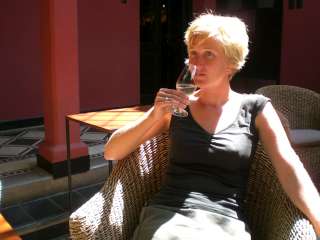 In my present state of mind*, I find it hard to imagine a better place in the world than Mendoza. They get 300 days of sun a year, the city is filled with huge, gorgeous trees, parillas (Argentine BBQ restaurants which universally serve gargantuan steaks) hover around almost every corner, and they are surrounded by wineries. Oh, and they’re within spitting distance of the Andes, not that I would ever spit wine.
In my present state of mind*, I find it hard to imagine a better place in the world than Mendoza. They get 300 days of sun a year, the city is filled with huge, gorgeous trees, parillas (Argentine BBQ restaurants which universally serve gargantuan steaks) hover around almost every corner, and they are surrounded by wineries. Oh, and they’re within spitting distance of the Andes, not that I would ever spit wine.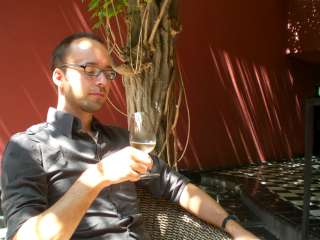 Anyway, I could go on and on about the wine but will limit myself here to talking about one particular wine tasting facility: Vines of Mendoza. I don’t really know how to label this place; it’s sort of a wine club, tasting room, wine-tour arranger, enthusiasts’ meeting place, wine promoter type place. (They make money by exporting local wines to Europe and America.) But for us, it’s just a great, relaxed place to go to taste, and learn about wine.
Anyway, I could go on and on about the wine but will limit myself here to talking about one particular wine tasting facility: Vines of Mendoza. I don’t really know how to label this place; it’s sort of a wine club, tasting room, wine-tour arranger, enthusiasts’ meeting place, wine promoter type place. (They make money by exporting local wines to Europe and America.) But for us, it’s just a great, relaxed place to go to taste, and learn about wine.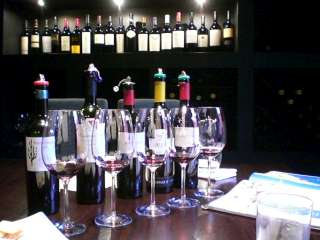 The hour and a half that followed was magnificent. We tasted five of Argentina’s Best wines, complete with an educated and friendly host who walked us through the regions, the varietals, the aging, the aromas and the tasting. (I’m edumacated in the wine, now.) After being so long in Asia without a drop of decent wine to be found, this was an absolutely exquisite way to spend the afternoon.
The hour and a half that followed was magnificent. We tasted five of Argentina’s Best wines, complete with an educated and friendly host who walked us through the regions, the varietals, the aging, the aromas and the tasting. (I’m edumacated in the wine, now.) After being so long in Asia without a drop of decent wine to be found, this was an absolutely exquisite way to spend the afternoon.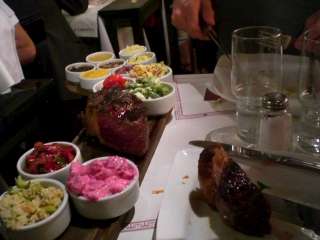 Two random couples we met raved about La Cabrera, a barbeque restaurant in Buenos Aries, one fellow saying he would return to BA just to go there. We showed up at 9pm, an early arrival by Argentinian standards, just to ensure we could get a seat without waiting, which we barely managed.
Two random couples we met raved about La Cabrera, a barbeque restaurant in Buenos Aries, one fellow saying he would return to BA just to go there. We showed up at 9pm, an early arrival by Argentinian standards, just to ensure we could get a seat without waiting, which we barely managed.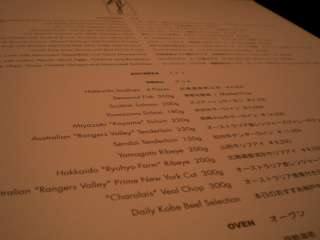 According to the menus, those were just appetizers but even in our alcohol infused state, we could not justify spending $80 for a rib eye steak or – perish the thought – $190 for the Kobe beef steak. We did have one more glass of wine, though. In total, for two people, two drinks each, two appetizers: $200CAD. Obscene, opulent, delicious, exquisite. Unrepeatable.
According to the menus, those were just appetizers but even in our alcohol infused state, we could not justify spending $80 for a rib eye steak or – perish the thought – $190 for the Kobe beef steak. We did have one more glass of wine, though. In total, for two people, two drinks each, two appetizers: $200CAD. Obscene, opulent, delicious, exquisite. Unrepeatable.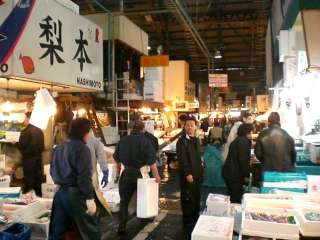 Rising at dawn, we visited the Tsukiji Fish Market for the height of the morning rush. After navigating our way through the trucks, vans and motorized trolleys, we found the main fresh fish market with hundreds of vendors selling fish whole, filleted or still alive. Men ran frozen tuna through enormous band saws while others filleted eel after eel or sliced off chunks of fish with a knife three feet long, any of these jobs requiring rubber boats, plastic pants and a wet suit like jacket to keep warm and dry.
Rising at dawn, we visited the Tsukiji Fish Market for the height of the morning rush. After navigating our way through the trucks, vans and motorized trolleys, we found the main fresh fish market with hundreds of vendors selling fish whole, filleted or still alive. Men ran frozen tuna through enormous band saws while others filleted eel after eel or sliced off chunks of fish with a knife three feet long, any of these jobs requiring rubber boats, plastic pants and a wet suit like jacket to keep warm and dry.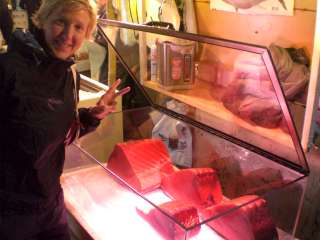 Some of the tourists wore plastic bags on their shoes, but that is dangerous on slippery concrete floors running with water and blood. With fish and guts everywhere, I was surprised by the complete lack of smell. Perhaps it’s different in the summer, but on our visit everything was surprisingly fresh.
Some of the tourists wore plastic bags on their shoes, but that is dangerous on slippery concrete floors running with water and blood. With fish and guts everywhere, I was surprised by the complete lack of smell. Perhaps it’s different in the summer, but on our visit everything was surprisingly fresh.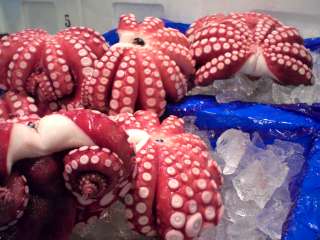 It was hard not to consider the enormity of it all—a vast industry cleaning the ocean of edible life. At no point could we see the entire market and this was only one market in one city. Live sea cucumber to whale bacon, all prepared or packaged to feed our enormous population.
It was hard not to consider the enormity of it all—a vast industry cleaning the ocean of edible life. At no point could we see the entire market and this was only one market in one city. Live sea cucumber to whale bacon, all prepared or packaged to feed our enormous population.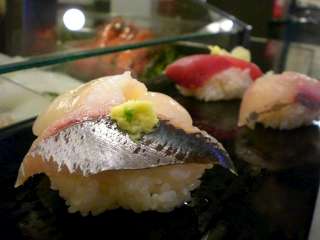 Those contemplations didn’t stop us from enjoying a sushi breakfast at one of the many restaurants that fringe the market. In Tokyo, few people speak English, but most people are used to dealing with people who don’t speak Japanese. In this case we were directed to the wall menu for a choice of the $20 set or the $30 set and an Engligh drink menu was provided. As the sushi chef completed a serving, he dropped it in front of us on a black laquered board that ran around the bar, which was used instead of a plate. Wow, so fresh. Most were the usual suspects, tuna and shrimp, but one animal we only reconginized from the fish market—a sort of dark flattened shrimp. It tasted much stronger than a shrimp, not something I’ll likely seek again.
Those contemplations didn’t stop us from enjoying a sushi breakfast at one of the many restaurants that fringe the market. In Tokyo, few people speak English, but most people are used to dealing with people who don’t speak Japanese. In this case we were directed to the wall menu for a choice of the $20 set or the $30 set and an Engligh drink menu was provided. As the sushi chef completed a serving, he dropped it in front of us on a black laquered board that ran around the bar, which was used instead of a plate. Wow, so fresh. Most were the usual suspects, tuna and shrimp, but one animal we only reconginized from the fish market—a sort of dark flattened shrimp. It tasted much stronger than a shrimp, not something I’ll likely seek again.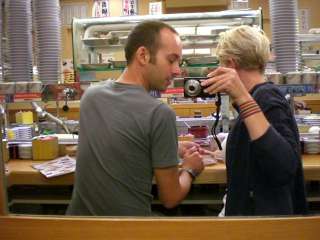 Just before we left Bangkok, we used up our last remaining bhat on a spicy green mango salad that was so spicy that I could see through time. We stopped in Seoul the next morning on a layover that was long enough to eat bibimbap with kimchi for breakfast, something we’ve been craving for months. Finally, we arrived in Japan and had a late lunch of a lot of sushi. I doubt we’ll be able to come close to replicating that phenomenon in the future, unless we have maple syrup in the morning and cross the border for American cheese in the afternoon. Doesn’t seem as exotic, though.
Just before we left Bangkok, we used up our last remaining bhat on a spicy green mango salad that was so spicy that I could see through time. We stopped in Seoul the next morning on a layover that was long enough to eat bibimbap with kimchi for breakfast, something we’ve been craving for months. Finally, we arrived in Japan and had a late lunch of a lot of sushi. I doubt we’ll be able to come close to replicating that phenomenon in the future, unless we have maple syrup in the morning and cross the border for American cheese in the afternoon. Doesn’t seem as exotic, though. Our last day in Bangkok was spent milling around CentralWorld, a new mall with a grocery store of culinary delights. It was rated the 3rd best food retailer in the world and best in Asia. Grocery aisles intertwine with sit-down options, where customers can order sushi, bistro food, or New York pizza. A liquor section had dozens of brands of beer we had never seen before. We mainly stayed near food court that overlooked the store.
Our last day in Bangkok was spent milling around CentralWorld, a new mall with a grocery store of culinary delights. It was rated the 3rd best food retailer in the world and best in Asia. Grocery aisles intertwine with sit-down options, where customers can order sushi, bistro food, or New York pizza. A liquor section had dozens of brands of beer we had never seen before. We mainly stayed near food court that overlooked the store. The Murahata Fruit Boutique, which was attached to the store, was particularly intriguing. Rather than buying a dozen apples or a bag of kiwi, one buys one apple the size of a softball or perhaps a pair of different apples, including one with a chinese character printed on the side. Whether the fruit is apple, kiwi or melon, each piece is the best of the farmers’ craft, the pinnacle of a simple tradition. Each is perfect in appearance and exceptional in flavour. The melons have perfect T-shaped stems, the kiwis are the size of a fist and the strawberries are bright red. I was able to sample one small piece of apple, which was mild and sweet, not acidic or sharp. As tempted as a was, I couldn’t convince myself to buy the $4 apple or the $20 melon.
The Murahata Fruit Boutique, which was attached to the store, was particularly intriguing. Rather than buying a dozen apples or a bag of kiwi, one buys one apple the size of a softball or perhaps a pair of different apples, including one with a chinese character printed on the side. Whether the fruit is apple, kiwi or melon, each piece is the best of the farmers’ craft, the pinnacle of a simple tradition. Each is perfect in appearance and exceptional in flavour. The melons have perfect T-shaped stems, the kiwis are the size of a fist and the strawberries are bright red. I was able to sample one small piece of apple, which was mild and sweet, not acidic or sharp. As tempted as a was, I couldn’t convince myself to buy the $4 apple or the $20 melon.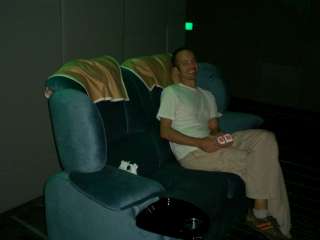 We did spend the extra $2 to get the sofa seat at the movie theatre when we watched Pursuit of Happiness. In addition to the typical cup holder, a small tray was provided and the seat backs reclined. And best of all, no arm rest to prevent snuggling.
We did spend the extra $2 to get the sofa seat at the movie theatre when we watched Pursuit of Happiness. In addition to the typical cup holder, a small tray was provided and the seat backs reclined. And best of all, no arm rest to prevent snuggling.
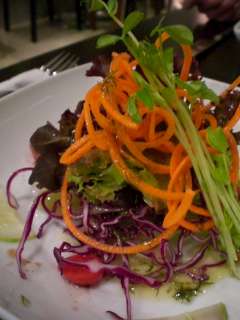 We ate lunch the first time we walked in: Hawaiian Chicken Burger and Fish & Chips, henceforth known as “the Best Chips/French Fries”. Simple enough dishes but they were crafted exceptionally well, and were remarkably reasonable in price, especially considering the care taken in preparation. We could barely wait 30 hours to return for dinner, which was a parma-wrapped steak with asparagus mashed potatoes for Marc and a mustard-crusted pork chop for me. Now this- this was outstanding. The steak was done perfectly to request and just melted in the mouth. Melted! My chop, served with warm raisin compote, was golden, garlicky, tasty, brilliant. Oh yeah! We also had an exquisite starter of chicken livers sauteed in a whiskey reduction; though, as this is the first chicken liver I’ve ever had, it doesn’t yet warrant a “Best Of” rating. We are going back for dinner tonight and my mouth is already watering. Unfortunately, they don’t serve wine, just beer. No liquor license yet?
We ate lunch the first time we walked in: Hawaiian Chicken Burger and Fish & Chips, henceforth known as “the Best Chips/French Fries”. Simple enough dishes but they were crafted exceptionally well, and were remarkably reasonable in price, especially considering the care taken in preparation. We could barely wait 30 hours to return for dinner, which was a parma-wrapped steak with asparagus mashed potatoes for Marc and a mustard-crusted pork chop for me. Now this- this was outstanding. The steak was done perfectly to request and just melted in the mouth. Melted! My chop, served with warm raisin compote, was golden, garlicky, tasty, brilliant. Oh yeah! We also had an exquisite starter of chicken livers sauteed in a whiskey reduction; though, as this is the first chicken liver I’ve ever had, it doesn’t yet warrant a “Best Of” rating. We are going back for dinner tonight and my mouth is already watering. Unfortunately, they don’t serve wine, just beer. No liquor license yet? Another place we credit ourselves with findin is Ricky’s Cafe. (It’s actually in the most recent Rough Guide travel guide but we don’t have that guide so I take credit for finding it on our own.) The reason this french toast wins the “Best Of” award is because it is actually banana french toast. Who would’ve thought? Mix egg with smashed up, fresh banana and use that to coat the bread before frying = fantastic. It was out of this world. We’ve been back for breakfast there every day but one since we’ve been in Bangkok; they also serve a delicious blue-cheese omelette.
Another place we credit ourselves with findin is Ricky’s Cafe. (It’s actually in the most recent Rough Guide travel guide but we don’t have that guide so I take credit for finding it on our own.) The reason this french toast wins the “Best Of” award is because it is actually banana french toast. Who would’ve thought? Mix egg with smashed up, fresh banana and use that to coat the bread before frying = fantastic. It was out of this world. We’ve been back for breakfast there every day but one since we’ve been in Bangkok; they also serve a delicious blue-cheese omelette. I would like to say that the majesty of the former residence of Lao Royalty inspired us to crave a more delicate cuisine but I would be lying. It was actually just a question of unbridled gluttony. But the residence was impressive, especially the Limoges china and bohemian crystal. And the antique sideboards in the dining room. (Can you see where this is leading?)
I would like to say that the majesty of the former residence of Lao Royalty inspired us to crave a more delicate cuisine but I would be lying. It was actually just a question of unbridled gluttony. But the residence was impressive, especially the Limoges china and bohemian crystal. And the antique sideboards in the dining room. (Can you see where this is leading?) And then there was the Laos restaurant owned by the same group called Three Nagas. With Doug and Amy, we treated ourselves to a traditional Laos feast with stewed water buffalo (for the record: chewy), various savoury soups, minced pork wrapped in lemon grass, and steamed fish stuffed with pork. The laminated article posted outside the restaurant said that this place offered a taste of Laos that is different from Vietnam, different from Thailand or Cambodia and they were right. We could taste Laos in the dishes, taste the unique flavours and the bold meats. Except what we couldn’t taste past the spiciness.
And then there was the Laos restaurant owned by the same group called Three Nagas. With Doug and Amy, we treated ourselves to a traditional Laos feast with stewed water buffalo (for the record: chewy), various savoury soups, minced pork wrapped in lemon grass, and steamed fish stuffed with pork. The laminated article posted outside the restaurant said that this place offered a taste of Laos that is different from Vietnam, different from Thailand or Cambodia and they were right. We could taste Laos in the dishes, taste the unique flavours and the bold meats. Except what we couldn’t taste past the spiciness.

